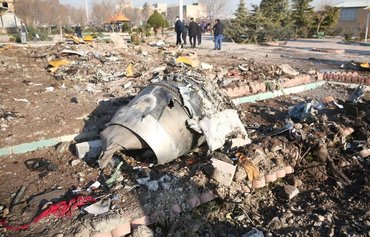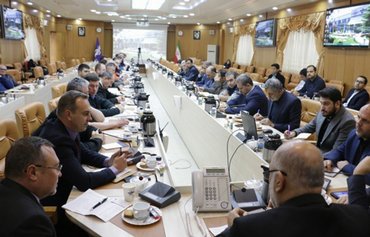Iran has struggled to contain the fallout over its handling of the air disaster that brought down a Ukrainian passenger plane, and the tragedy has seen hundreds of angry protesters, most of them students, take to the streets.
New video footage has emerged showing two Iranian missiles tearing through the night sky and hitting the plane, sending the aircraft down in flames and killing all 176 passengers and crew on board.
The blurry film, shot from a rooftop in a village four miles from an Iranian military site, shows the Boeing 737 catching fire before it exploded and crashed.
Iran had for days denied claims that the plane had been downed by its missiles.
But on Saturday, Islamic Revolutionary Guard Corps (IRGC) aerospace commander Brig. Gen. Amirali Hajizadeh acknowledged a missile operator had mistaken the plane for a cruise missile and opened fire.
New videos circulating on social media purported to show fresh protests on Tuesday evening (January 14th) at universities in Tehran, along with clashes between students and the Basij Resistance Force, a component of the IRGC.
Earlier, around 200 mainly masked students gathered at Tehran University and were locked in a tense standoff with youths from the Basij.
Around 30 people have been arrested in the protests over the air disaster, according to judiciary spokesman Gholamhossein Esmaili.
On Tuesday, Tehran said it had made its first arrests over the shooting down of the plane, though it gave no details.
Rift between regime, people
Mehdi Rahmanian, director of reformist daily Shargh, told AFP that the latest protests showed there was a "real rift between the people and the authorities".
"I hope that (police restraint) will continue and that no lives are lost, because this could be a catalyst for more protests," he said.
In another sign of growing dissent, a group of artists cancelled their participation in the Fajr festival, held each year on the anniversary of the 1979 Islamic Revolution, according to Hamshahri newspaper.
Even before the downing of the plane, there was widespread anger inside the Islamic Republic against the Iranian regime, experts told Al-Mashareq.
The regime has been accused of brutally repressing nationwide protests that broke out in mid-November over the state of the economy, which many demonstrators have blamed on poor governance, they said.
Demonstrators have accused Iran of focusing its resources on its expansionist foreign policy, directed by the IRGC and carried out by affiliated militias, even as the country's economy is on the brink of collapse.
The pursuit of this external policy comes at the expense of meeting the basic needs of the Iranian people, who are suffering as a result of dilapidated infrastructure and a general decline in state services, analysts said.
Iranian dissident writer and political analyst Ali Narimani accused the Iranian regime of "failure and negligence" when it comes to maintaining infrastructure.
"The IRGC is more interested in expanding its presence in the Middle East and supporting the militias affiliated with it with weapons, equipment and money," he told Al-Mashareq.
"There is a great deal of anger in Iran because of this negligence, in addition to the stifling economic crisis the Iranian people are facing," he said.
Iran forced to admit lies
Iran was forced to admit it had lied about shooting down the plane after "dozens of pieces of evidence confirmed the plane was shot down by a guided missile", said Al-Sharq Centre for Regional and Strategic Studies researcher Sami Gheit.
In his opinion, the crash "was caused by negligence and lack of regard for the lives and safety of civilians, as the IRGC and the Iranian army are supposed to close the airspace to civilian flights when they take a military action".
He also noted that a large base housing ballistic missiles is located very close to the civilian airport in Tehran.
The reaction to the plane incident can be seen on social media and in the protests that are being held in most Iranian provinces, Tehran native and Iranian dissident Hossein Shayan told Al-Mashareq.
There have been calls for regime change inside Iran, he said, and for the dismissal and prosecution of senior officials.
The crash "provoked the Iranian people to the maximum extent, especially as the authorities insisted on lying to the international and local public by asserting that the plane crashed due to a technical malfunction or defect", he said.
President Hassan Rouhani on Wednesday called for "national unity" and flagged the need for changes to the way Iran is run after the downing of the airliner.
The missile attack was launched in retaliation for a US drone strike that killed Iran's most prominent general, Qassem Soleimani, who headed the IRGC's Quds Force.
At least 59 mourners were trampled to death at a funeral procession for Soleimani in his hometown of Kerman, in south-east Iran, on January 7th.
Iran has also been wracked by flooding since Friday that has claimed the lives of at least three people and left hundreds of villages cut off.
Referring to the spate of disasters which he described as "unimaginable" and "unacceptable", Rouhani said they should lead to a "big decision" about Iran's political system.

![Iranian forces are seen at the crash site after a Ukrainian airliner was shot down by an Iranian missile on January 8th, killing all 176 on board. [Photo via Fars News Agency]](/cnmi_am/images/2020/01/23/21941-Iran-Ukraine-crash-600_384.jpg)







Iran is a despicable state that’s lying to itself and its people. The strange thing is that they’re following that goat that is posing as a god and claiming to be Muslim although he is a Sikh and hostile to Islam.
Reply1 Comment(s)